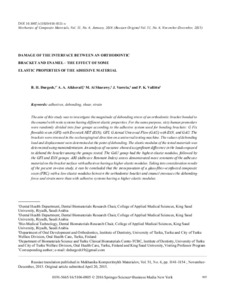Damage of the Interface Between an Orthodontic Bracket and Enamel – the Effect of Some Elastic Properties of the Adhesive Material
Durgesh BH; Alkheraif AA; Al Sharawy M; Varrela J; Vallittu PK
https://urn.fi/URN:NBN:fi-fe2021042714765
Tiivistelmä
The aim of this study was to investigate the magnitude of debonding stress of an orthodontic bracket bonded to the enamel with resin systems having different elastic properties. For the same purpose, sixty human premolars were randomly divided into four groups according to the adhesive system used for bonding brackets: G Fix flowable resin (GFI) with Everstick NET (ESN), GFI, G Aenial Universal Flow (GAU) with ESN, and GAU. The brackets were stressed in the occlusogingival direction on a universal testing machine. The values of debonding load and displacement were determined at the point of debonding. The elastic modulus of the tested materials was determined using nanoindentation. An analysis of variance showed a significant difference in the loads required to debond the bracket among the groups tested. The GAU group had the highest elastic modulus, followed by the GFI and ESN groups. ARI (Adhesive Remnant Index) scores demonstrated more remnants of the adhesive material on the bracket surface with adhesives having a higher elastic modulus. Taking into consideration results of the present in-vitro study, it can be concluded that the incorporation of a glass-fiber-reinforced composite resin (FRC) with a low elastic modulus between the orthodontic bracket and enamel increases the debonding force and strain more than with adhesive systems having a higher elastic modulus.
Kokoelmat
- Rinnakkaistallenteet [27094]
